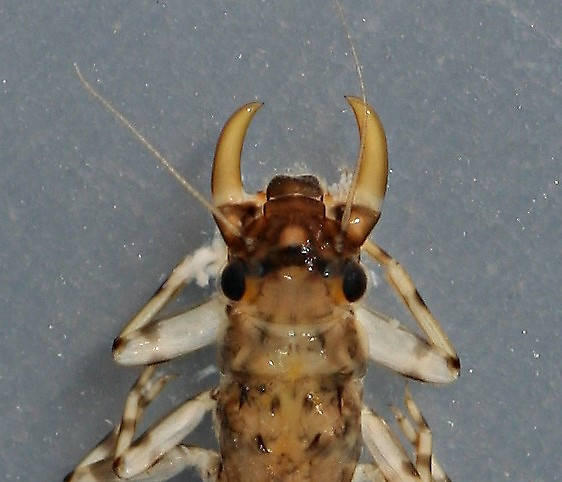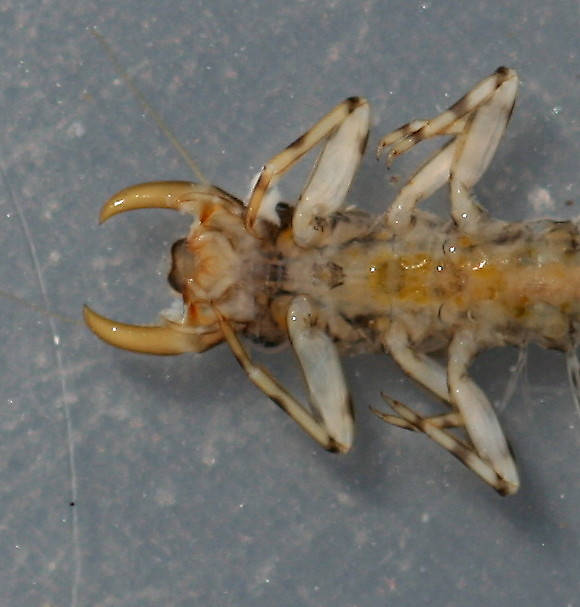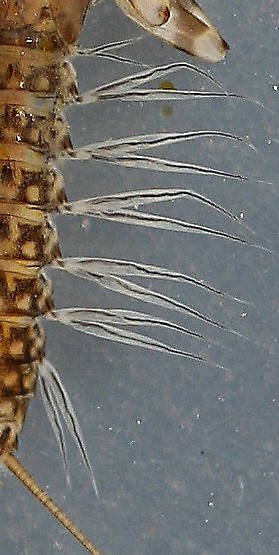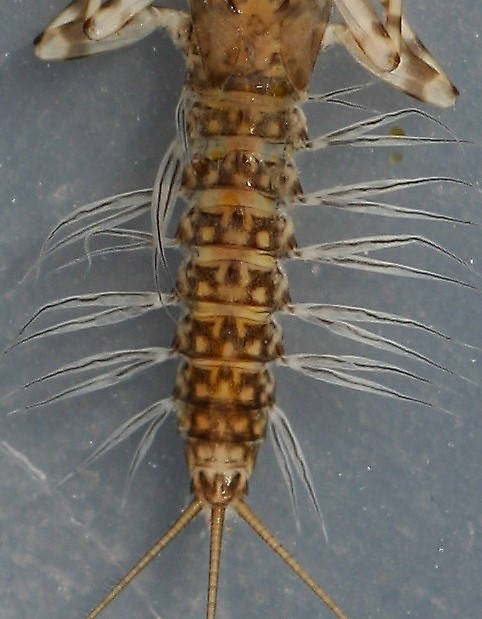Blog & Latest Updates
Fly Fishing Articles
Insects by Common Name


> > Paraleptophlebia helena
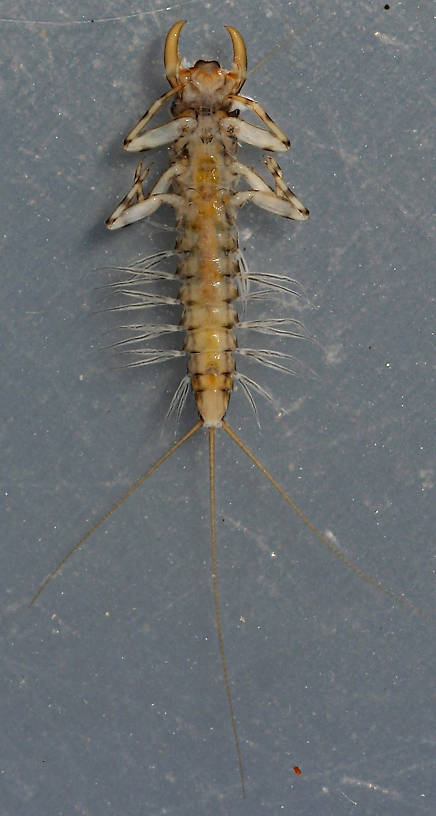
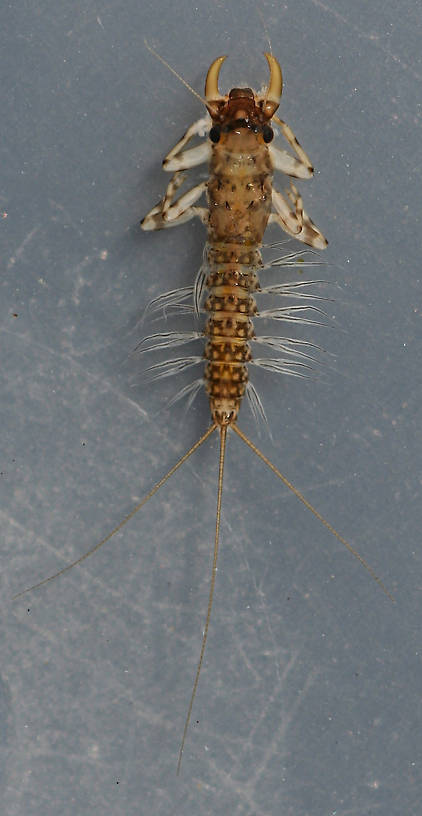
| Millcreek | August 24th, 2014, 12:19 pm | |
| Healdsburg, CA Posts: 356 | Just thought I'd throw a strange one in here.These nymphs were collected in Mill Creek (tributary to Dry Creek which empties into the Russian River) near Healdsburg, CA. As far as I can tell they're Paraleptophlebia helena. I used Day's description of them for a final identification. The paper that includes their description can be seen here http://www.ephemeroptera-galactica.com/pubs/pub_d/pubdayw1952p17.pdf. According to Day's account the original specimens he described were taken from Mill Creek. They're most commonly found from late summer through early winter among gravel and cobble that have leaf litter (primarily white alder) under them. All pictures are of one specimen collected on September 1, 2012. Specimen is in alcohol but pictures were taken shortly after collection and color is representative of live specimens. The nymph is 7 mm (excluding cerci). | |
| Entoman | August 24th, 2014, 1:01 pm | |
| Northern CA & ID Posts: 2604 | Very cool, Mark. Due to location I think you are correct but the more common bicornuta also matches Day's data. The dark V and adjacent pale rectangle on the head is common to both. He was reporting these characters as the way to differentiate from zayante. Unfortunately, his work is far from comprehensive. | |
| "It's not that I find fishing so important, it's just that I find all other endeavors of Man equally unimportant... And not nearly as much fun!" Robert Traver, Anatomy of a Fisherman | ||
| Millcreek | August 24th, 2014, 2:32 pm | |
| Healdsburg, CA Posts: 356 | Yeah, I'd have to say that information on the nymphs of the tusked species of Paraleptophlebia is sketchy at best in California. Probably should just be classified in the P. bicornuta group (includes packii, bicornuta, zayante and helena) for the time being. Personally, I'd still lean towards P. helena because of location and description, but I've been wrong before. And you're right about Day's work on the nymph not being comprehensive enough to separate it from some of the other Paraleptophlebia nymphs. I think he got stretched a little thin considering all the work he was doing on Ephemeroptera. Gotta admire him though, he did a lot of pioneering work on the California fauna. | |
| Entoman | August 24th, 2014, 5:37 pm | |
| Northern CA & ID Posts: 2604 | Absolutely! Dated as it is its still the benchmark for us. | |
| "It's not that I find fishing so important, it's just that I find all other endeavors of Man equally unimportant... And not nearly as much fun!" Robert Traver, Anatomy of a Fisherman | ||
| Taxon | August 24th, 2014, 6:25 pm | |
Site Editor Royse City, TXPosts: 1350 | Mark- Well done. | |
| Best regards, Roger Rohrbeck www.FlyfishingEntomology.com | ||
| Millcreek | August 24th, 2014, 8:04 pm | |
| Healdsburg, CA Posts: 356 | Kurt-Absolutely! Dated as it is its still the benchmark for us. It is a bit dated, 1952, the year I was born.:) Roger- Mark- Thanks | |
| Crepuscular | August 24th, 2014, 10:58 pm | |
| Boiling Springs, PA Posts: 923 | Mark, thanks for posting this one! | |
| Entoman | August 24th, 2014, 11:57 pm | |
| Northern CA & ID Posts: 2604 | Yeah, you guys don't see these tuskers back East...;) | |
| "It's not that I find fishing so important, it's just that I find all other endeavors of Man equally unimportant... And not nearly as much fun!" Robert Traver, Anatomy of a Fisherman | ||
| Millcreek | August 25th, 2014, 10:00 am | |
| Healdsburg, CA Posts: 356 | Eric-Mark, thanks for posting this one! You're welcome. Had to put it up there, it's one of those you need to see it to believe it ones. | |
| Creno | August 30th, 2014, 9:49 pm | |
| Grants Pass, OR Posts: 305 | Mark - Specimens from the type locality are taxonomically important and you should label that specimen as a possible topotype. If you can get a good series of fresh material of any species from its type locality you should try and submit some for DNA analysis to add to the world DNA library. | |
| Millcreek | August 31st, 2014, 11:54 am | |
| Healdsburg, CA Posts: 356 | Dave - Good idea about labelling it as topotype. I'm not too likely to get new specimens right now. Our area is having a drought period and Mill Creek is extremely low and dry over large portions. I've got specimens from 2012 as well as ones taken earlier. All are stored in alcohol and I'm not sure how that would affect DNA sampling. I would assume that the best way of preserving specimens for DNA analysis would be to freeze or dry them. What is the world DNA library? Are you referring to BOLD? | |
| Entoman | August 31st, 2014, 12:46 pm | |
| Northern CA & ID Posts: 2604 | The good news about alcohol preservation is that it won't impede DNA testing. So I've been told anyway. The guy to send your samples to is Luke. Hopefully he'll see this thread and comment. | |
| "It's not that I find fishing so important, it's just that I find all other endeavors of Man equally unimportant... And not nearly as much fun!" Robert Traver, Anatomy of a Fisherman | ||
| Creno | August 31st, 2014, 1:53 pm | |
| Grants Pass, OR Posts: 305 | High percent (95%+) ETOH is best if you use alcohol. Denatured, methyl, isopropyl, etc. do not work well, if at all. Frozen or dry are probably better. But remember your freezer is not really frozen - most freezers now-a-days have a defrost cycle that partially thaws stuff. The best thing I have found for successful barcoding DNA is to get it done as quickly as possible after collection, however you store it. Luke Jacobus would be a good one to check with for deposition. I like to put topotype material wherever the type collection is housed. That way future researchers have material at one locality if they have to visit for examination. But if you can get a long series of topotype material then it is good to spread it around to the various collections that specialize in whatever group you have. I like BOLD because that is the only one I know how to sorta use, and it has alot of caddis info - but there are others. BOLD allows you to "include public records" in your analysis, but I don't really understand where these come from. There should be others reading this forum that understand the data analysis procedures for DNA work. | |
| Millcreek | August 31st, 2014, 2:20 pm | |
| Healdsburg, CA Posts: 356 | Found this by Luke on another thread."Collection fluid" usually refers to ethanol (EtOH). I recommend collecting into a solution of 90% EtOH/10% water. After an hour, or a little more, I'll drain off the solution and add more of the same concentration. I'll do this a few times until the liquid stops turning yellow. Finally, I'll put the specimens into a solution of 70% EtOH/30% water. However, if I am going to try to extract DNA from the specimens (ever), I'll collect into 100% (200 proof) EtOH and continue changes, using 100% each time. This often will leave specimens brittle, and sometimes they will extrude tissue. A final resting place of 70% is the best for medium-term storage and handling. Keeping specimens in alcohol in a freezer will extend their useful "life"time.. Looks like you guys were right. | |
Quick Reply
You have to be logged in to post on the forum. It's this easy:
Related Discussions
| Title | Replies | Last Reply |
| Re: Rhyacophila betteni group In Rhyacophila Caddisfly Larva by Creno | 2 | Aug 10, 2019 by Creno |
| Re: Bug collection In the Identify This! Board by Xavier_Carp | 5 | Feb 23, 2008 by Shawnny3 |
| Re: bug collection jars/vials? In the Identify This! Board by Adirman | 3 | May 19, 2011 by Adirman |
| Re: Little J caddis? In the Identify This! Board by CaseyP | 9 | Dec 22, 2007 by Martinlf |
| Re: Tiny Black Caddis hatch, late fall - Nov 26 to be exact_ Spring Creek Southern MO In the Caddisfly Family Hydroptilidae by Dai_sca | 21 | Dec 11, 2019 by Pdcox |
| Re: A mystery late-season Epeorus In Male Epeorus frisoni Mayfly Dun by Troutnut | 7 | May 9, 2012 by Entoman |
| Wing Material In Fly Tying by Unsinkable1 | 0 | |
| Re: Another Caddisfly In the Identify This! Board by Crepuscular | 18 | Feb 7, 2013 by Crepuscular |
| Re: Mayfly from spring creek In the Identify This! Board by Al514 | 11 | May 18, 2007 by Troutnut |
| Re: Gilvipes or atripes? In Female Dicosmoecus atripes Caddisfly Adult by Entoman | 7 | Dec 19, 2016 by Clark2016 |
Troutnut.com is copyright © 2004-2024 Jason
Neuswanger (email Jason). See my FAQ for information about use of my images.
 privacy policy
privacy policy

